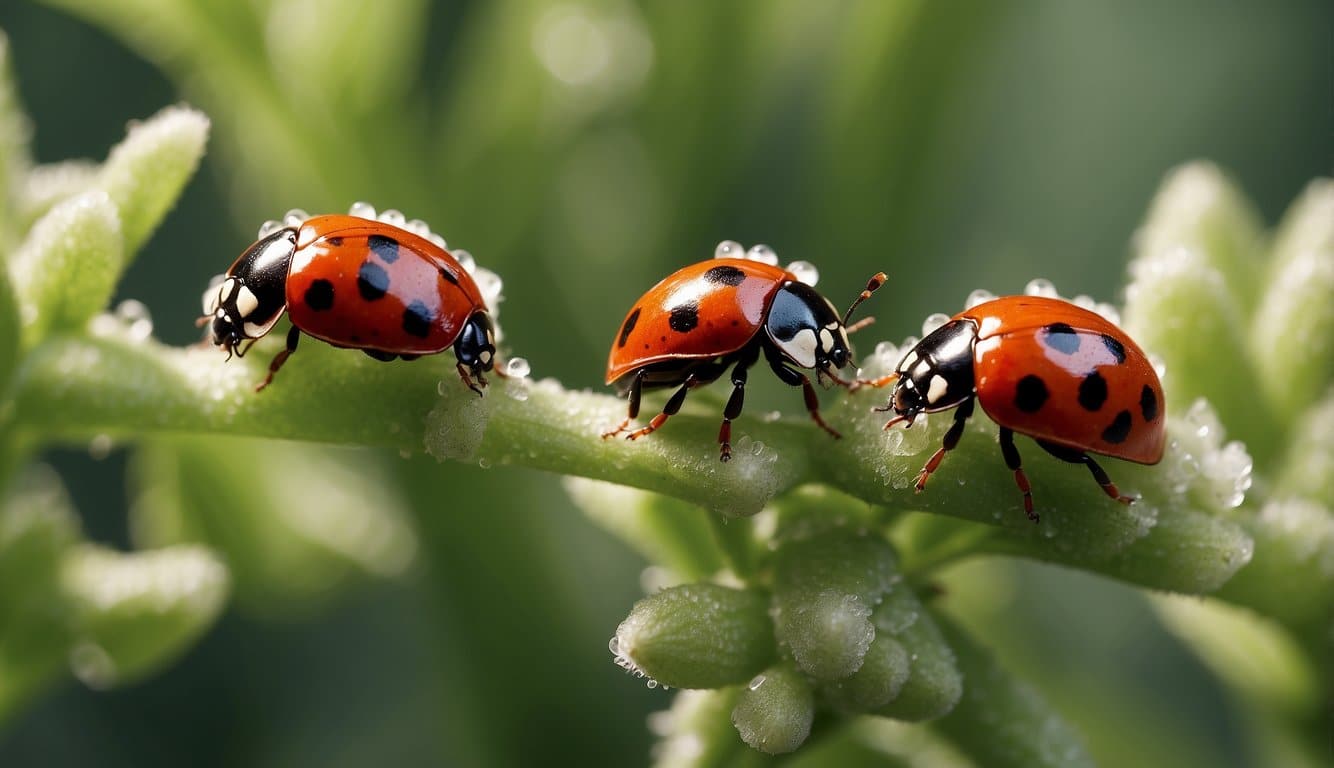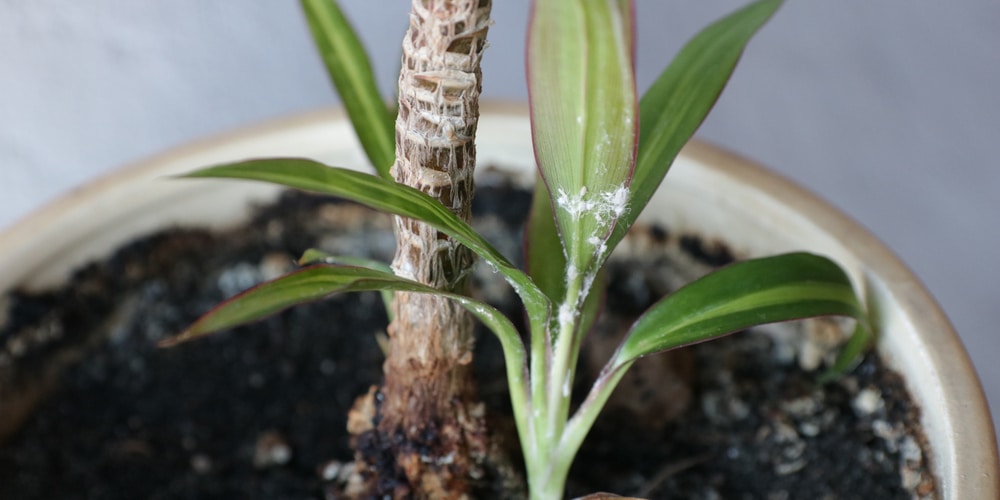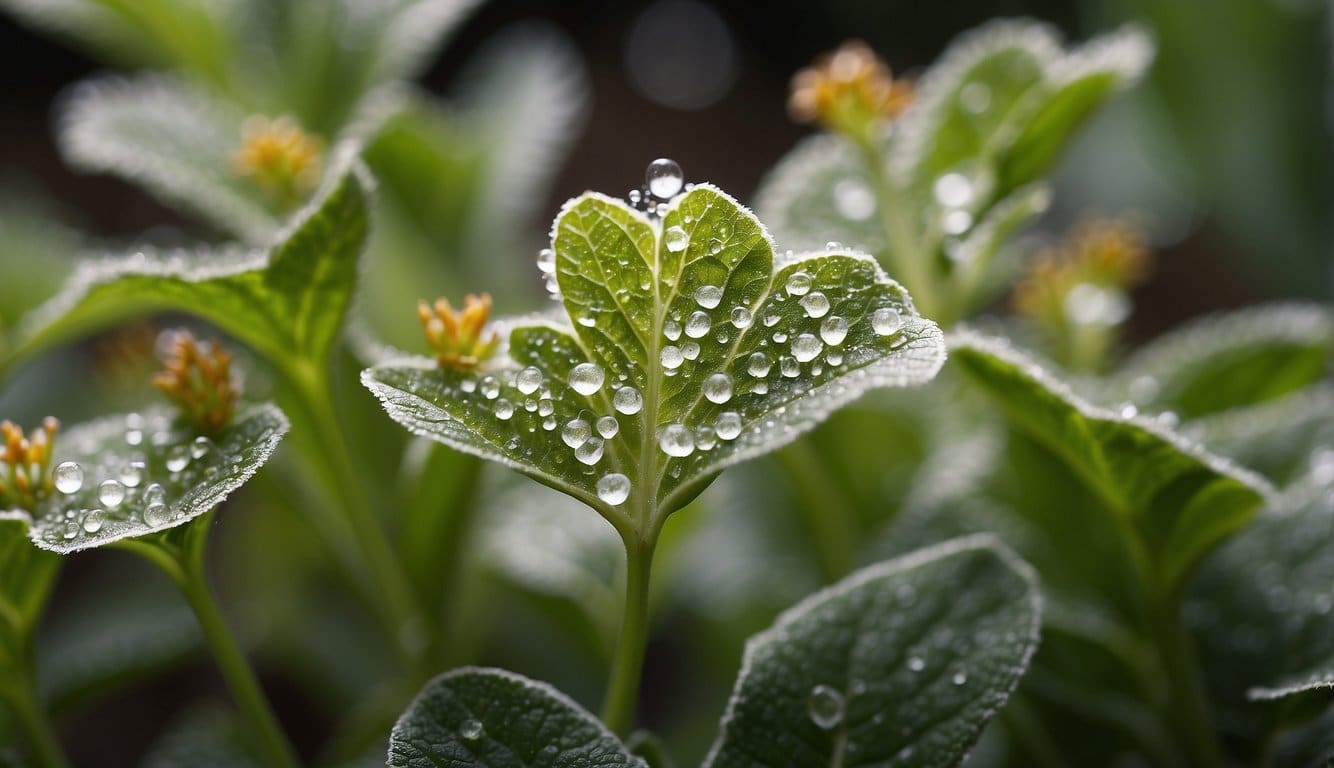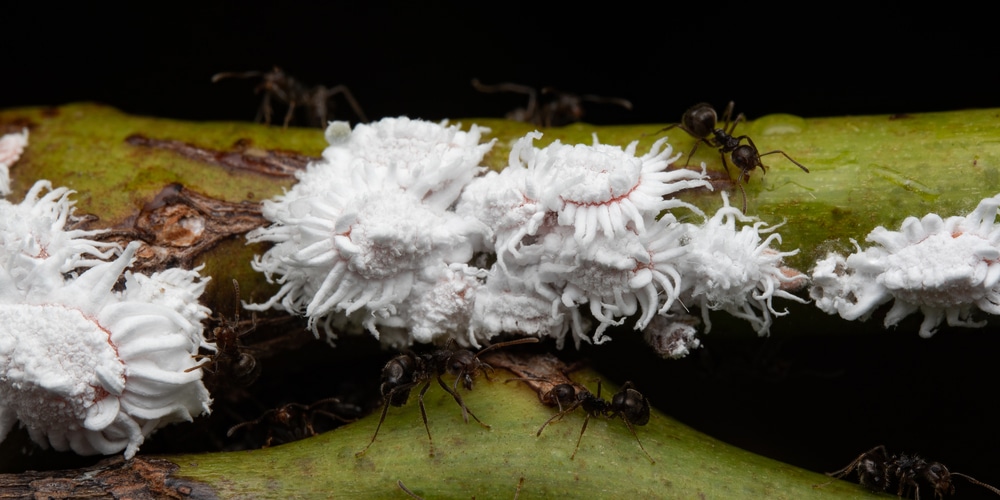Make Sure You’re Looking at a Mealybug
Before you start the bug battle, it’s crucial you know exactly who you’re up against. Recognize mealybugs by their distinct traits and sneaky behaviors to ensure your plants stand a fighting chance!
Visual Characteristics
- Color: Mealybugs typically bear a white, cottony appearance that can make them look like small bits of fluff or mold at a glance.
- Shape: These pests are small, oval-shaped insects that can grow up to 1/5 inch, resembling tiny, cotton-coated grains of rice.
- Markers: Beyond their woolly coats, some adult females develop filamentous waxy tails, giving them an atypical body outline compared to other plant pests.
Habitat and Behavior
- Residency: Mealybugs love cozying up in the warm, sheltered nooks of your plants, such as under leaves, near stem joints, or in root crevices.
- Signatures: They leave behind tell-tale signs of their presence:
- Sticky residue known as honeydew
- Sooty mold fungi that thrive on honeydew
- Clusters of eggs in white, cottony sacs
Keep your eyes peeled for these pest patterns, and when you spot them, gear up for action!
Now you’re equipped to spot these sneaky bugs; it’s time to learn how to send them packing.
Natural Predators and Biological Control

Tackling mealybugs can be like a spy mission in your garden—finding the right allies to take out these pests without causing collateral damage to your plants.
Beneficial Insects
- Lacewings: Deploy these green guardians to munch away mealybug populations. Their larvae are particularly voracious, handling even the heftiest of infestations.
- Ladybugs: Not just pretty faces, ladybugs feast on mealybugs like buffets, especially in their larval stage. They’re the SWAT team of pest control, swooping in to clean up your plants.
Using Biological Pesticides
- Neem Oil: Think of it as a botanical shield; when you mix neem oil with water and a drop of soap, it smothers and repels mealybug marauders.
- Insecticidal Soaps: These soaps don’t just make bubbles—they break the water tension, sticking to mealybugs and disrupting their nasty nibbling habits. Apply it carefully to hit your targets and save your plants.
Organic and Home Remedies
If you’re facing a mealybug invasion, fear not! You can tackle these pesky pests with ingredients likely already in your cupboard or garden shed.
Neem Oil Application
- Potency: Neem oil is a formidable foe against mealybugs, disrupting their life cycle and preventing them from causing further damage.
- How to Use:
- Mix: Combine 1-2 teaspoons of neem oil with a quart of water and a few drops of mild liquid soap.
- Spray: Thoroughly coat the affected plants, targeting nooks where mealybugs hide.
Learn more about the natural wonders of neem by checking out The Spruce’s insights on organic pest control.
Soapy Water Solution
- Efficiency: A classic remedy, soapy water acts like a natural insecticide, breaking down mealybugs’ outer layer.
- Recipe:
- Combine: 4 teaspoons of gentle liquid soap with 1 quart of water.
- Apply: Generously mist your plants, paying close attention to the undersides of leaves.
For the perfect soap mixture to combat these bugs, Plant Care Today offers a simple yet effective recipe.
Alcohol Swabs
- Quick Fix: Alcohol is great for spot treatment, quickly killing individual mealybugs on contact.
- Method:
- Dip: Moisten a cotton swab or pad with 70% isopropyl alcohol.
- Swipe: Gently dab the mealybugs you see on your plant’s leaves and stems.
Chemical Treatments
When dealing with mealybugs, you have the option to bring out the big guns: chemical treatments. These potent solutions can help you reclaim your plants, but it’s important to use them carefully and follow label instructions to the letter.
Systemic Insecticides
- What They Do: Systemic insecticides work from the inside out. When you apply them to your plants, they’re absorbed into the plant’s system. As mealybugs feed on the plant, they ingest the insecticide and are eliminated. It’s a clever way to target the pests without excessive spraying.
- How to Use Them:
- Apply as directed, typically as a soil drench for your plant’s roots to absorb.
- Be Patient: It may take some time for the systemic insecticide to circulate throughout the plant.
Contact Sprays
- What They Do: Contact sprays are your direct line of defense. They work on contact and are especially effective for visible mealybug infestations.
- How to Use Them:
- Direct Aim: Spray directly onto the mealybugs. Make sure to hit all those sneaky spots where they hide.
- Repeat if Necessary: You might need multiple applications, as these sprays only kill on contact and won’t protect against new arrivals.
Preventive Measures
In your battle against mealybugs, it all starts with being proactive. From regular checks to smart quarantine steps, let’s dive into the specifics that can save your green buddies.
Regular Plant Inspection
- Inspect Weekly: Make it a habit to scrutinize your plants once a week. Look closely at leaves, especially the undersides and the areas where they join the stems.
- Spot Early Signs: Be on the lookout for telltale signs of mealybug presence, like cottony white masses or discolored, wilted leaves.
Proper Quarantine Procedures
- Isolate New Plants: Always quarantine new plants for at least two weeks before introducing them to your plant collection.
- Disinfect Tools: Regularly clean and disinfect your gardening tools and pots to prevent the spread of mealybugs and other pests.
Frequently Asked Questions
In dealing with mealybugs, you might have a lot of questions about natural methods, specific insecticides, and quick extermination techniques. Let’s dive into some of the most common queries to help you tackle these pesky insects effectively.
What are natural methods to combat mealybug infestations?
Natural remedies are a great start for managing mealybugs. You can spritz your plants with a mixture of neem oil and water to deter these pests. Another option is using a solution comprised of water and a few drops of dish soap to smother the bugs.
Which insecticides are most effective against mealybugs?
For a more aggressive approach, systemic insecticides could be your best bet. These chemicals are absorbed by the plant and can dispatch mealybugs as they feed. Contact insecticides that contain pyrethrins may also be effective, but you’ll want to apply these carefully to avoid harming beneficial insects.
Can mealybugs infest indoor plants, and how can they be treated?
Mealybugs can certainly move in on your indoor plants. If you spot an infestation, try removing them with a strong jet of water or dabbing them with alcohol-soaked cotton swabs. Consistency is key, so keep an eye out for any returnees.
How can one tackle mealybug issues in outdoor gardens?
Outdoor mealybug infestations can be addressed by releasing beneficial insects like ladybugs, which feed on mealybugs. Additionally, pruning infested areas and applying neem oil or insecticidal soaps can reduce their populations.
What steps can quickly eliminate mealybugs from your plants?
Here are some swift actions to combat mealybugs:
- Isolate the infested plant to prevent spread.
- Use a cotton swab dipped in rubbing alcohol to kill individual bugs on contact.
- For larger invasions, spray insecticidal soap or horticultural oil. Make sure to cover all plant surfaces thoroughly.
Are home remedies like Dawn dish soap effective for mealybug extermination?
Yes, a solution made with mild dish soap, such as Dawn, can work wonders.
Mix a few drops into a spray bottle with water. Like a mealybug secret agent, stealthily attack the pests by coating the leaves and stems of the plant.


